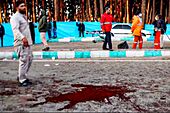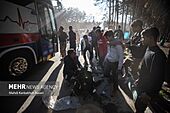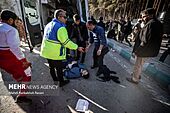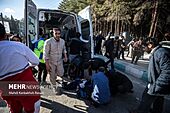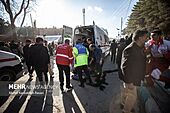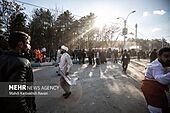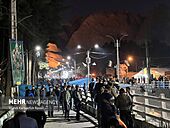2024 Kerman bombings facts for kids
Quick facts for kids 2024 Kerman bombings |
|
|---|---|
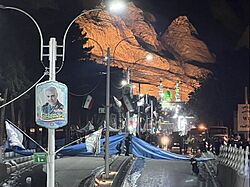 The site of the bombings on the route towards the Martyrs' Cemetery with the dome of the Saheb al-Zaman mosque visible in the background |
|
| Location | Kerman, Iran |
| Date | 3 January 2024 15:50–16:00 IRST (UTC+03:30) |
| Deaths | 103 (+2) |
| Injured | 284 |
| Perpetrator(s) | Islamic State – Khorasan Province |
On January 3, 2024, two bombs exploded at a ceremony in Kerman, Iran. People were gathered to remember Qasem Soleimani, a powerful Iranian general, at his grave. The attacks killed at least 103 people and hurt 284 others.
Iran's government called it a terrorist attack. It was the deadliest attack of its kind in Iran since 1978. The next day, a group called ISIS said they were responsible. ISIS is a Sunni extremist group, and Iran is mostly Shia. The United States believed the attack was carried out by ISIS-K, a branch of ISIS in Afghanistan.
Contents
What Happened Before
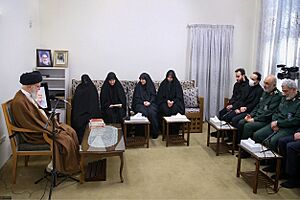
General Qasem Soleimani was a very important military leader in Iran. He was the head of the Quds Force, a special part of Iran's military. Many people saw him as the second most powerful person in Iran, after Supreme Leader Ali Khamenei.
Soleimani was killed in Iraq by a United States drone attack on January 3, 2020. He was in charge of secret missions and helped friendly groups like Hamas and Hezbollah with money, weapons, and information.

When Soleimani was buried in Kerman in 2020, a large crowd caused a stampede. This accident killed at least 50 people and injured over 200.
The 2024 bombing happened when there were high tensions in the Middle East. This was due to the 2023 Israel–Hamas war and other conflicts nearby. Just before the bombings, an Israeli drone strike killed a Hamas leader in Lebanon. Also, an Israeli airstrike killed an Iranian general in Syria.
U.S. Warning to Iran
The United States secretly warned Iran about a possible terrorist attack by the Islamic State before the bombings. This warning was based on U.S. intelligence about ISIS's plans. The U.S. government has a "duty to warn" policy. This means they warn other countries about serious threats, even if they are not allies.
A U.S. official said they gave the warning "in part because we do not want to see innocent lives lost in terror attacks." Even with this warning, Iran could not stop the attack.
The Bombings
The two explosions happened during a procession. People were walking towards Soleimani's grave at the Golzar Shohada cemetery. This cemetery is near the Saheb al-Zaman mosque. The event was to mark four years since Soleimani's death.
The first bomb went off about 700 meters from the grave, near a parking lot. The second bomb exploded about one kilometer away, on Shohada Street. Many people had run to this street after the first blast. The bombs were placed to avoid being found at security checkpoints. The explosions happened about 10 to 20 minutes apart.
Iranian media reported that the attack used two briefcase bombs. These bombs were placed at the entrance and set off remotely. One witness said a bomb was in a trash bin. Another bomb was reportedly in a car. An official from Kerman province said it was a terrorist attack.
At least 94 people were killed, and 284 were injured. Twenty-seven of the injured were in critical condition. Among those who died were 23 students, 14 Afghan citizens, and three paramedics. The paramedics were helping after the first explosion and were caught in the second one. Most of the deaths and injuries came from the second blast. Some injured people were also trampled in the panic.
After the Attack
The Iranian Red Crescent Society helped injured people at the ceremony. They faced challenges because crowds blocked the roads. Hospitals in Kerman and nearby areas were ready to treat the victims.
After the explosions, crowds gathered at the cemetery. They chanted slogans against Israel and America.
A large funeral for the victims was held on January 5 in Kerman. Iran's president, Ebrahim Raisi, and IRGC commander Hossein Salami attended. Authorities also called for public rallies against the bombings after the funerals.
Two days after the attack, Iran's Ministry of Interior ordered walls to be built. These walls would be on Iran's borders with Afghanistan and Pakistan.
Later in January 2024, Iran launched missile attacks in Iraq, Syria, and Pakistan. They said these attacks were in response to the Kerman bombing.
Suspect Arrested
Iran's Ministry of Intelligence announced an arrest in July 2024. They caught a key person believed to be behind the bombings. This person was identified as Abdullah Quetta.
The ministry stated that information from Quetta helped them find other people involved in the plot. It also helped uncover "many Takfiri conspiracies."
Reactions to the Attack
In Iran
Ali Khamenei, Iran's Supreme Leader, promised a "hard response" to the attack. He said those responsible would face "definite repression and just punishment."
Other Iranian religious leaders also strongly condemned the bombings. They called for severe punishment for those who carried them out.
President Ebrahim Raisi canceled a trip to Turkey. He declared January 4 a national day of mourning for the victims. The Interior Minister, Ahmad Vahidi, promised a quick response. Other officials also vowed to find and punish the terrorists. Soleimani's daughter, Zeinab, hoped the attackers would be found and punished.
Around the World
Many countries and leaders sent their condolences. Russian president Vladimir Putin called the attack "shocking in cruelty and cynicism." Turkish president Recep Tayyip Erdoğan sent his sympathies to the "friendly and brotherly" people of Iran. Pope Francis also expressed deep sadness over the "loss of life."
Pakistan's foreign minister condemned the "inhuman terrorist attacks." Syria, Saudi Arabia, and the United Arab Emirates also condemned the attack. Afghanistan, Iraq, Armenia, Azerbaijan, and India expressed support for Iran. North Korean leader Kim Jong-un also condemned the bombings.
International Groups
The United Nations and the European Union also condemned the attack.
Other Groups
Hezbollah leader Hassan Nasrallah said the victims were "martyrs." He said they died for the same cause that Soleimani led. The Houthi movement in Yemen also condemned the attacks. They called them "criminal bombings" that tried to harm Iran.
Who Was Responsible?
On January 4, the Islamic State claimed responsibility for the attack. They posted a statement on Telegram. Later, they shared pictures of two masked people. They claimed these were brothers who carried out the attack.
Based on U.S. intelligence, the attack was done by ISIS–K. This is the branch of the Islamic State in Afghanistan. The United States had warned Iran about an ISIS attack before the bombings. U.S. officials said the warning was detailed enough to help stop or lessen the attack.
Before ISIS claimed responsibility, Iranian president Ebrahim Raisi blamed Israel. Other Iranian officials also blamed Israel for the bombings. The Quds Force commander, Esmail Qaani, claimed the attackers were "supplied by the United States and the Zionist regime."
The United States said there was no reason to believe Israel was involved. They called suggestions of U.S. involvement "ridiculous." They also expressed sympathy for the victims. An Israel Defense Forces spokesperson said they were focused on the combat with Hamas.
Even after ISIS claimed responsibility, some Iranian officials continued to accuse the U.S. and Israel. IRGC commanding general Hossein Salami said ISIS "has disappeared." He claimed its members "only act as mercenaries" for American and Israeli interests.
Authorities later arrested two people for helping the suspected terrorists. In total, 35 people believed to be involved in the attack were arrested.
One of the attackers was identified as a citizen of Tajikistan. On January 11, Iran's Ministry of Intelligence said they identified the mastermind. He was a Tajikistani national known as Abdollah Tajiki. He entered Iran illegally in December 2023. He made the bombs and then left Iran on January 1. They also identified one of the bombers as a 24-year-old Tajikistani and Israeli national. He was trained by Islamic State in Afghanistan before entering Iran.
Gallery
See also
- Assassination and terrorism in Iran
- List of terrorist incidents in 2024
- List of terrorist incidents linked to Islamic State – Khorasan Province
- List of terrorist incidents linked to the Islamic State
- Haft-e Tir bombing, the deadliest bomb attack in Iran before Kerman
- Crocus City Hall attack, a terrorist attack in Russia orchestrated by ISIS-K later in 2024


